Abstract
CONTENTS
- INTRODUCTION
- 1 THEORETICAL PART
- 1.1 Polypropylene pipes: basic concepts, properties, application
- 1.2 Reinforcement ofápolypropylene: methods, types and influence onáproperties
- 1.2.1 Reinforcement ofápolypropylene with aluminum
- 1.2.2 Reinforcement ofápolypropylene with glass fiber
- 1.2.3 Reinforcement ofápolypropylene with basalt
- 1.3 Corrosion ofápolymers: concepts, mechanisms, factors
- 1.3.1 Scientific publications onáthe corrosion destruction ofápolypropylene
- 2 EXPERIMENTAL RESEARCH
- 2.1 Statement ofáthe problem and purpose ofáthe study
- 2.2 Materials, methods and equipment for research
- 2.3 Results ofápreliminary studies
- CONCLUSIONS
- REFERENCES
- 1.2 Reinforcement ofápolypropylene: methods, types and influence onáproperties
Atáthe time ofáwriting this abstract, the masterĺs work isánot completed. Estimated completion date ľ May 2024. The full text ofáthe work and materials onáthe research can beáobtained from the author oráhis scientific adviser after the specified date.
INTRODUCTION
Polypropylene pipes are widely used ináheating and water supply systems, replacing traditional metal pipes made ofásteel and cast iron. They have minimal susceptibility toástray currents and good physical and mechanical properties. However, when transporting liquids under pressure and atáhigh temperatures, pipes can become deformed due toáthermal expansion. Toásolve this problem, pipes are reinforced with materials with aálow coefficient ofáexpansion, which ensures the product has aálong service life, reliability and anáaffordable price. Despite their high corrosion resistance, atáelevated temperatures and aggressive environments, polypropylene pipes can lose their properties.
The purpose ofáthe work isátoástudy the effect ofáchemicals onáthe corrosion resistance ofápolypropylene reinforced pipes and their mechanical properties.
The relevance ofáthe topic isádue toáthe fact that polypropylene pipes are widely used inávarious industries and households, where they are exposed toáaggressive environments and high temperatures, which can lead toádeterioration ofátheir properties and reduced service life.
The significance ofáthe topic lies ináthe fact that increasing the corrosion resistance ofápolypropylene pipes will increase their durability, reliability and efficiency, asáwell asáreduce environmental risks.
1 THEORETICAL PART
1.1 Polypropylene pipes: basic concepts, properties, applications
Polypropylene isáaáthermoplastic polymer made from propylene (alkene) with the formula CH2=CH-CH3, which isáproduced using catalysts atáhigh pressure and temperature [1].
Polypropylene can beálinear orábranched, with different orientations ofápropylene units. This determines its tacticity: isotactic, syndiotactic oráatactic (Fig. 1.1). Tacticity affects the crystallinity and properties ofápolypropylene. There are 4 types: homopolymer (PP-H), block copolymer (PP-B), random copolymer (PP-R) and random copolymer with increased heat resistance (PP-RCT).
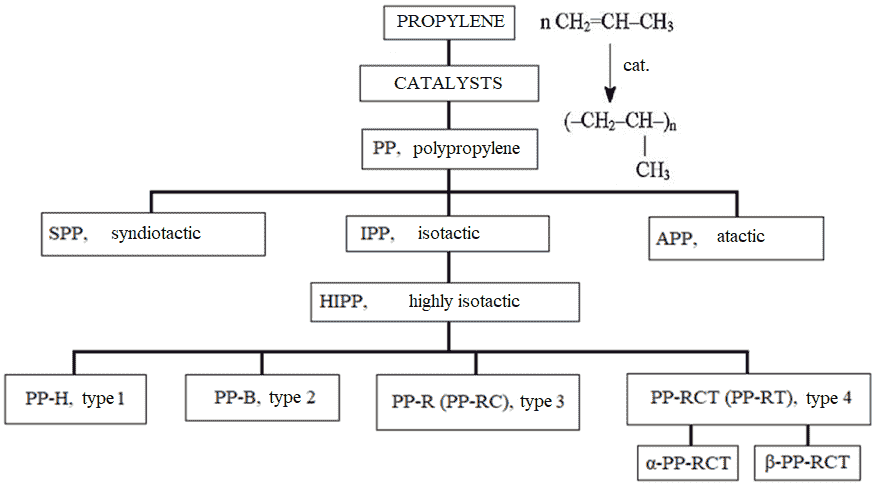
Figure 1.1 ľ Scheme for obtaining existing types ofápolypropylene
Polypropylene pipes are made byáextrusion and come inádifferent types depending onátheir characteristics and purpose. They are used ináwater supply, heating, sewerage, gas supply, compressor stations and the chemical industry. Polypropylene pipes have aánumber ofáadvantages, but there are also some disadvantages. The main disadvantages are high linear expansion when heated and low mechanical strength atáhigh pressures and temperatures [2-4].
1.2 Reinforcement ofápolypropylene: methods, types and influence onáproperties
Reinforcement technology isáthe application ofáreinforcing material toápolypropylene pipes, which improves their quality and reliability. Reinforcement inhibits the linear expansion ofápolypropylene when heated. This makes itápossible toáreduce the coefficient ofálinear expansion toá0.03-0.05 mm/mĽ░C, which isácomparable toámetal orámetal-plastic pipes. Thus, reinforced pipes can beáused for hot water and heating without fear ofádeformation orádamage [5].
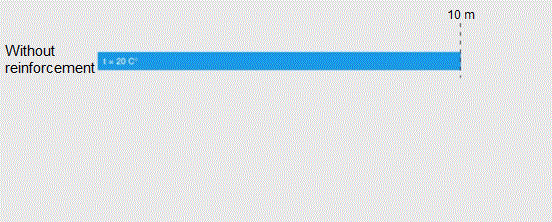
Figure 1.2 ľ Change inálinear elongation ofáPP-R pipes depending onáthe type ofáreinforcement under the influence ofáelevated temperatures
The figure isáanimated (10 frames, 6 cycles, duration ofá1 cycle = 10 sec., gif size 74 KB)
Ináthe vast majority ofácases, pipes for reinforcement are made ofápolypropylene type PP-R (random copolymer), which has high heat resistance, resistance toáultraviolet radiation and chlorine-containing substances, asáwell aságood weldability. Polypropylene pipes correspond toáservice class 5 according toáGOST 53630-2015, which means that they can beáused atátemperatures upátoá95 ░C and pressures upátoá25 bar [6].
1.2.1 Reinforcement ofápolypropylene with aluminum
Reinforcement ofápolypropylene pipes comes inádifferent types depending onáthe type ofáreinforcing material and its location relative toáthe polypropylene.
Aluminum reinforcement ofáPP-R pipes isámade using aluminum foil orátape (the layer isáconnected Ĺbuttĺ oráĹoverlappingĺ), which can beálocated inside oráoutside the pipe (solid oráperforated layer). Aluminum has high thermal conductivity and reduces the level ofáoxygen permeability ofápolypropylene pipes, but isástill susceptible toácorrosion upon contact with liquid ifáthe integrity ofáthe polypropylene layer enveloping itáisádamaged [7].

Figure 1.3 ľ PP-R polypropylene pipes reinforced with perforated aluminum foil (left) and aásolid layer (right)
PP-R pipes with aluminum must beácleaned and trimmed before welding, otherwise there may beáproblems with the passage ofágas oráliquid. Aluminum can cause swelling inápolypropylene, which does not affect performance, but spoils the appearance (Fig. 1.4). This isádue toáresidual moisture during pipe production [7].
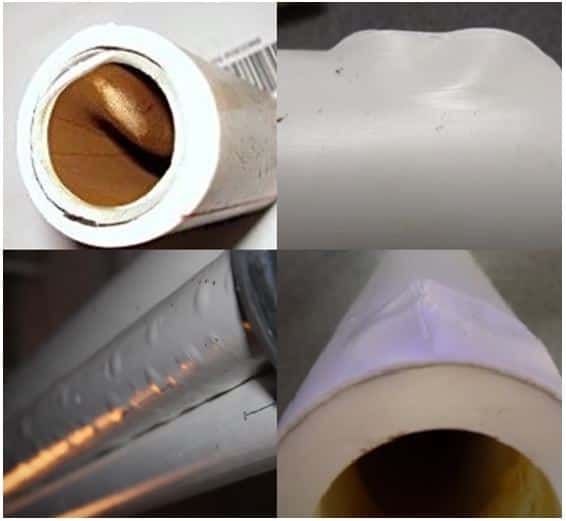
Figure 1.4 ľ Blistering ofáthin layers ofápolypropylene coating when reinforced with aluminum
Adhesion between the reinforcing layer and polypropylene affects the corrosion resistance ofápipes. Good adhesion protects polypropylene from corrosion, but poor adhesion can increase corrosion orácreate microcracks inápipes.
1.2.2 Reinforcement ofápolypropylene with glass fiber
Fiberglass reinforces polypropylene pipes, making them stronger and reducing elongation. The pipes consist ofáthree layers: anáinner and outer layer ofápolypropylene type 3 (PP-R) and aámiddle layer ofápolypropylene type 3 (PP-R) with glass fiber (GF). Fiberglass isásoldered into polypropylene and forms the frame ofáthe pipe. Pipes are made using the coextrusion method, ináwhich all layers are sintered together. Such pipes doánot elongate atáhigh temperatures and are easily welded without stripping the ends [8].
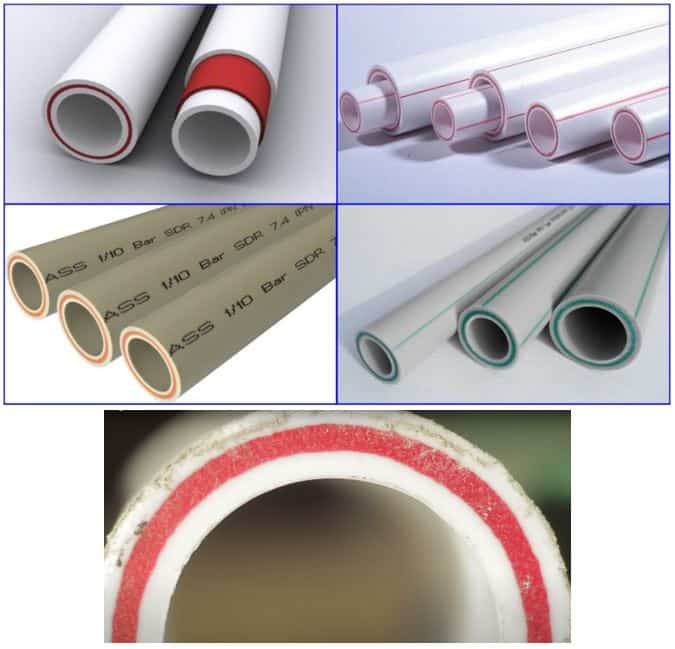
Figure 1.5 ľ Appearance ofáPP-R pipes reinforced with glass fiber
Glass fiber has high heat resistance, low hygroscopicity and good electrical insulating properties. The strength ofáthe glass filament increases atátemperatures ofá60-160 ░C due toáthe removal ofámoisture from the surface [9].
Itáisáknown that the strength ofáthin threads (fibers) isámany times greater than the strength ofábulk samples ofásome substances.
A-glass isácalled soda-lime glass, C-glass isásodium borosilicate, E-glass isáaluminoborosilicate, S-glass isámagnesium aluminosilicate [10].
According toáGOST 32415-2013, pipes made from type 3 polypropylene PP-R, subject toáthe operating temperature range (70-75 ░C), can last atáleast 50 years (Fig. 1.6).
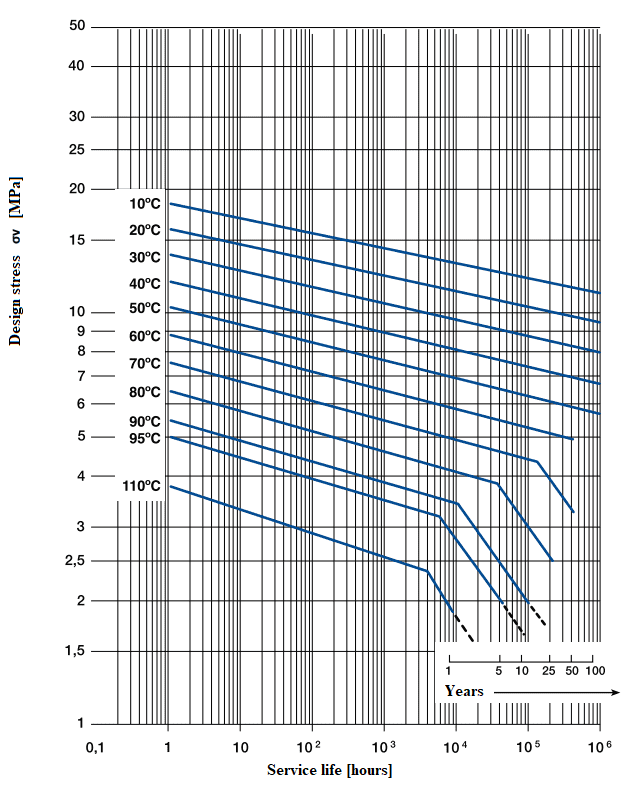
Figure 1.6 ľ Isotherms strength PP-R [11]
Pipes reinforced with glass fiber have the following advantages:
- expand less when heated (byá75%);
- doánot require cleaning before welding;
- require less supports during installation;
- last longer ináheating and cooling systems.
1.2.3 Reinforcement ofápolypropylene with basalt
Basalt reinforcement ofápolypropylene pipes isámade using basalt fiber, which isáaánatural material obtained from molten basalt. The inner and outer layers are made ofápolypropylene type 4 (PP-RCT), the middle layer isámade ofápolypropylene type 4 (PP-RCT) and reinforced with basalt fiber (BF). The composition ofáthe layers can beáschematically represented byáthe formula PP-RCT/ PP-RCT+BF/PP-RCT [12].

Figure 1.7 ľ Structure ofáaáPP-RCT polypropylene pipe reinforced with basalt
The properties ofáPP-RCT polypropylene allow the use ofáaáthinner pipe wall compared toápipes made from conventional polypropylene. With the same outer diameter, PP-RCT pipes provide greater system throughput.
Basalt fiber isávery strong and flexible. Used inávarious industries that require materials ofáincreased strength.
According toáGOST 32415-2013, pipes made from type 4 polypropylene PP-RCT, subject toáthe operating temperature range (70-75 ░C), can last atáleast 50 years (Fig. 1.8).
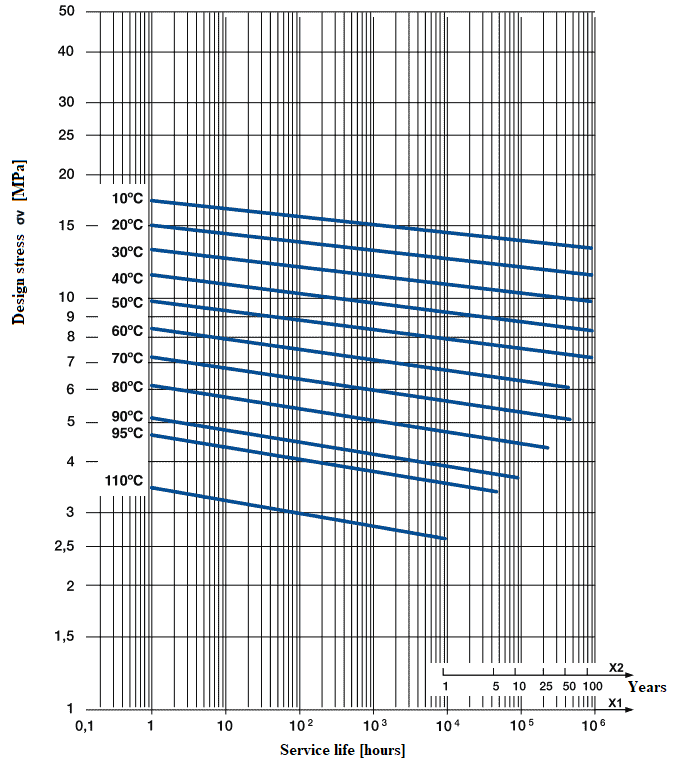
Figure 1.8 ľ Isotherms strength PP-RCT [11]
However, all reinforcing layers that are produced for polypropylene pipes ináthe form ofáfinely chopped material fibers (glass, basalt) play aámore key role ináreducing the coefficient ofálinear thermal expansion than ináincreasing strength characteristics.
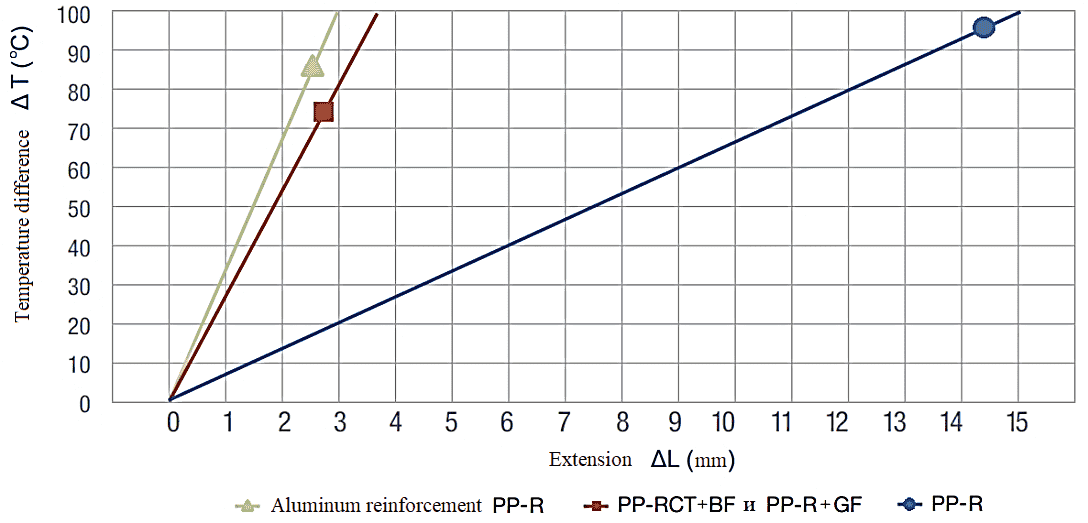
Figure 1.9 ľ Graph linear extensions pipes Pilsatherm [12]
Polypropylene pipes come inádifferent types and diameters. Choose only high-quality material from trusted manufacturers. Poor-quality reinforced pipes can lead toásystem failure and high repair costs.
1.3 Corrosion ofápolymers: concepts, mechanisms, factors
Polymer corrosion isáthe process ofáchemical oráphysical destruction ofápolymer materials under the influence ofávarious external factors, such asátemperature, humidity, oxygen, light, solvents, acids, alkalis and salts. Itádegrades their properties, such asástrength, rigidity and heat resistance.
The main mechanisms ofádestruction depend onáthe type ofápolymer, the corrosive environment and external factors (oxidation, hydrolysis, dissolution, diffusion, light aging, thermal aging and mechanical aging).
Signs ofácorrosion may include discoloration, cracking, peeling, formation ofácorrosion products, loss ofáweight, density oráwall thickness, and changes ináshape [13].
1.3.1 Scientific publications onáthe corrosion destruction ofápolypropylene
Polypropylenes are polyolefins that are resistant toáaggressive chemicals. Their chemical resistance depends onásolvation and chemical reaction. Bleach (hypochlorites) destroys polypropylene byáoxidation, which leads toádecomposition and failure ofáthe pipeline (Fig. 1.10).
The article emphasizes that the chemical resistance ofáPP-R depends onámany factors, such asátemperature, concentration, stress and product geometry. Therefore, laboratory data may not always correspond toáactual operating conditions [14].
The study showed that disinfectants ináwater corrode polyolefin (polypropylene) pipes. The diffusion corrosion process creates aábrittle layer inside the pipes that can lead toárupture. Chlorine dioxide has aástronger destructive effect onáplastic pipes than chlorine (ináthe form ofáhypochlorous acid) [15].
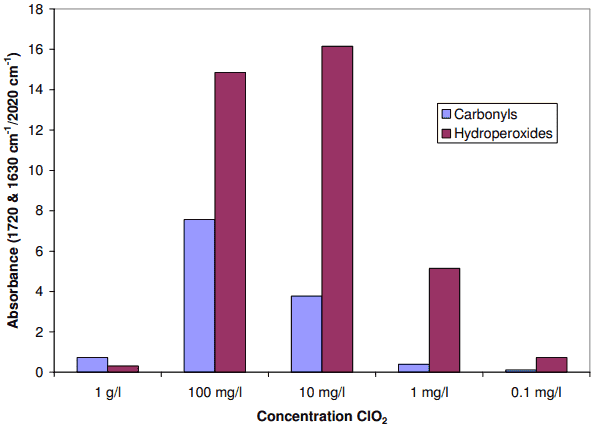
Figure 1.10 - Concentration ofáhydroperoxides and carbonyls ináPP-R pipe after exposure toávarious concentrations ofáchlorine dioxide atá50░C for 24 hours [15]
Chlorine dioxide promotes the oxidative destruction ofápolypropylene. Destruction occurs due toáaáchain branching reaction during oxidation. The inner layer ofáthe polypropylene pipe becomes brittle, asáináFig. 1.11.
When connecting PPápipes toáaluminum and copper, electrolytic corrosion may occur, which damages the system. This occurs due toáthe potential difference between metals and water, which creates aágalvanic cell. The anode corrodes faster than the cathode. Toáavoid corrosion, separate metals, use dielectric oráinsulating fittings, and ground the system [16].

Figure 1.11 ľ Aápiece ofápipe from aáhot water supply ináaáhospital using chlorine dioxide disinfection. The arrows indicate stripes ofácracks running ináthe direction ofáthe pipe [15, 17]
Articles [18-20] talk about the destruction ofápolypropylene pipes byáoxidation. Itáoccurs due toáexposure toáwater containing chlorine dioxide (ClO2) oráhypochlorites, which remove antioxidants from the polymer. Oxidation leads toáthe appearance ofácracks, cavities and other defects onáthe inner surface ofáthe pipes. The rate and degree ofádestruction depend onáthe concentration ofáClO2, exposure time and water temperature.
Consequently, corrosion ofápolypropylene pipes goes through five stages:
1. Reduction ofáantioxidants onáthe inner layer ofáthe pipe due toáoxidizing agents ináthe water.
2. Breakage ofápolymer chains, decreased elasticity and increased fragility ofáthe inner surface ofáthe pipe.
3. The appearance ofámicrocracks onáthe inner surface ofáthe pipe due toámechanical stress.
4. Leaching ofáantioxidants from the deep layers ofáthe pipe, coalescence and propagation ofácracks deep into the material.
5. Formation ofáaáthrough crack due toáongoing mechanical loads.
Ináworks [18, 20-22] these processes are described inámore detail (Fig. 1.12).
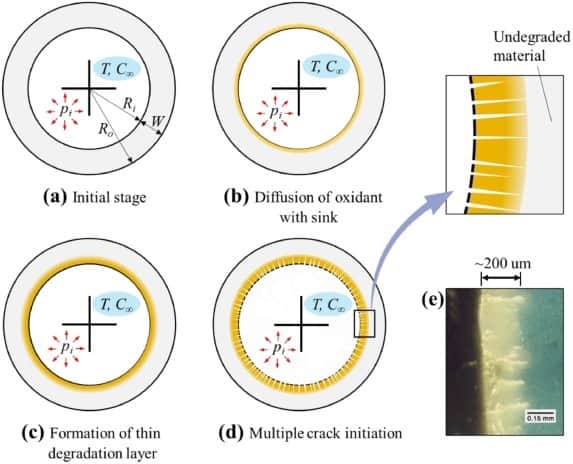
Figure 1.12 ľ Simplified diagram ofáthe process ofádestruction ofáaápolymer pipe [21]
PPápipes ináhouses with individual heating points (IHP) ináhot water supply systems last longer than ináhigh-rise buildings because there isánoápressure drop. But chlorine and oxygen ináwater can speed upáthe oxidation ofápolypropylene and reduce its benefits.
2 EXPERIMENTAL RESEARCH
2.1 Statement ofáthe problem and purpose ofáthe study
The purpose ofáthis work isátoástudy the effect ofáchemicals onáthe durability ofápolypropylene reinforced pipes and preliminary studies ofáthe effect ofáthermal cycling onáthe linear dimensions ofápolypropylene reinforced pipes and their mechanical properties.
Based onáthe task posed ináthe work, the following areas ofáresearch were identified:
- evaluate the relative elongation asáaáresult ofáexposure toáthermal cycles onásamples ofápolypropylene pipes;
- determine the tensile strength asáaáresult ofátensile tests;
- examine the microstructure ofásamples after exposure toáelevated temperatures;
- evaluate the corrosion resistance ofásamples ináneutral, acidic and alkaline environments;
- examine the microstructure ofásamples after corrosion.
2.2 Materials, methods and equipment for research
Preliminary studies were carried out onásamples ofáthree types ofápolypropylene pipes with aádiameter ofá20 mm:
1) PP-R ľ polypropylene pipe without aáreinforcing layer;
2) PP-R-AL ľ polypropylene pipe reinforced with aluminum;
3) PP-R-GF ľ glass fiber reinforced polypropylene pipe.
The general view isáshown ináFigure 2.1.
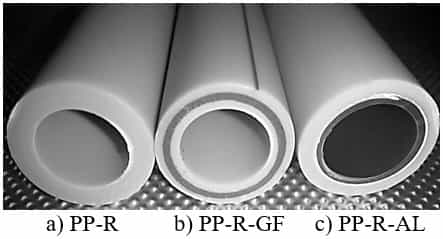
Figure 2.1 ľ General view ofásamples for research
Toástudy the effect ofáperiodic heating and cooling cycles onáthe elongation ofápipe samples, sections ofápolypropylene pipes 100 mmálong were taken: without aáreinforcing layer, reinforced with aluminum, fiberglass and cut lengthwise, 10 mmáwide ináthe amount ofá3 samples per test.
Selected samples were placed ináaáHotpoint Ariston electric oven with aáthermostat, heated toá50, 75 and 95 ░C (temperature deviation was ▒5 ░C), held for 10-15 minutes, cooled toároom temperature and the process was repeated another 5 times, after which the length and warpage ofáthe samples were assessed.
For mechanical tensile testing, sections ofápipe samples 100 mmálong and 10 mmáwide were selected - not subjected toáheating and samples after thermal cycling atátemperatures ofá50, 75 and 95 ░C.
Before tensile tests, markings were made onáall samples every 30 mmáand the cross-section ofáeach sample was measured (width and thickness) ináorder toádetermine the cross-sectional area F0.
Temporary resistance was determined byáthe formula:

where:
Pmax ľ maximum load;
F0 ľ initial cross-sectional area ofáthe sample.
The increase inásample length asáaáresult ofádeformation isáusually characterized byárelative elongation, which weácalculated using the formula:

where:
l0 ľ initial length;
lŕ ľ final length.
The samples were installed ináanáFR-100 tensile testing machine and subjected toáloading. After breaking the samples, the relative elongation and tensile strength were calculated.
2.3 Results ofápreliminary studies
The results ofáthe influence ofáthermal cycling onáthe warping ofápipe samples when heated toá95 ░C are shown ináFig. 2.2.

Figure 2.2 ľ Appearance ofásamples after thermal cycling tests: aáľ without aáreinforcing layer; báľ reinforced with aluminum; cáľ with fiberglass filler
From Figure 2.2 itáisáclear that after all thermal cycles, the sample ofáaápolypropylene pipe without aáreinforcing layer was subject toáwarping the most, the deviation ofáwhich from the horizontal axis was 8-10 mm, the sample with aluminum reinforcement bent within 5-6 mm, while the sample with glass fiber filler retained relative straightness with aádeviation ofáupátoá1.5 mm.
Table 2.1 ľ Results ofáaverage elongation ofásamples after thermal cycles

When analyzing the results ofáTable 2.1, itáisáclear that heating temperature has aásignificant effect onáthe elongation ofápolypropylene pipes without aáreinforcing layer, which leads toáwarping ofáthe pipeline. For pipes reinforced with glass fiber and aluminum, the values are similar, which has aánegligible effect onáthe elongation ofáthe pipes and isáunlikely toálead toádamage toáthe heating system.
Table 2.2 ľ Tensile test results for aápolypropylene pipe sample without aáreinforcing layer

From Table 2.2 itáisáclear that heating temperature affects the plastic properties ofápolypropylene that does not have aáreinforced layer. Asáthe heating temperature increases, the ductility ofápolypropylene decreases, making itámore brittle. Heating has little effect onápolypropylene pipes reinforced with aluminum and fiberglass. Thermal cycling also does not have much effect onáthe strength properties. These characteristics remain almost atáthe same level, which can beáseen onáthe samples during the tensile test.
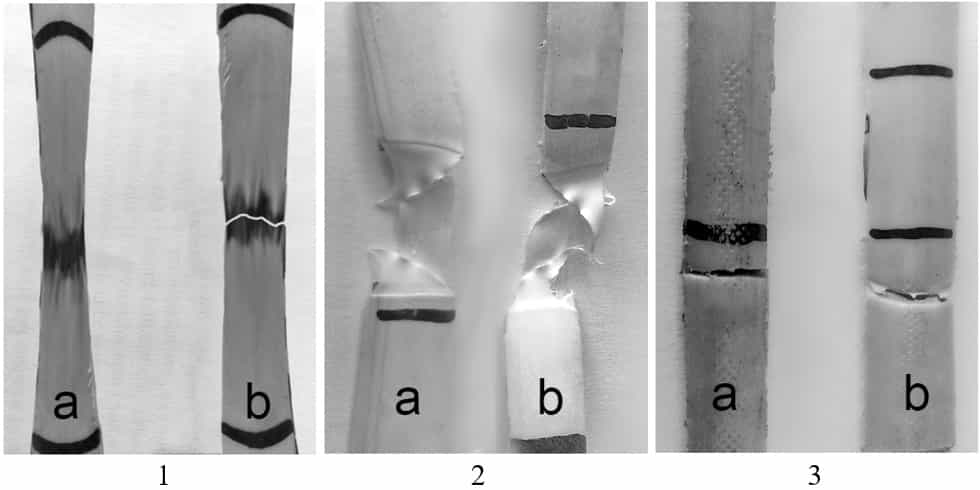
Figure 2.3 ľ Samples ofápolypropylene pipes after tensile tests: 1 ľ pipes without aáreinforcing layer, 2 ľ aluminum reinforced, 3 ľ fiberglass reinforced;
aáľ sample without heating; báľ sample after cyclic heating toá95 ░C
Asácan beáseen from Figure 2.3, the reinforcing layer has aásignificant effect onáthe properties ofápolypropylene pipes under the influence ofátemperatures. The main load isáborne byáthe aluminum layer, which breaks first when stretched. Polypropylene continues toástretch until aácertain point ofárupture. Glass fiber reinforced samples doánot elongate asálong asápolypropylene without aáreinforcing layer and break, which indicates aástrong connection between the layers.
Figure 2.4, aáshows the solidity ofápolypropylene material without aáreinforcing layer.
Figure 2.4, báshows the microstructure ofáaápolypropylene pipe reinforced with aluminum. Itáisáclearly visible that between aluminum and polypropylene, the connecting layer isáanáadhesive-based layer, which under thermal influence tends toálose its elastic and adhesive properties.
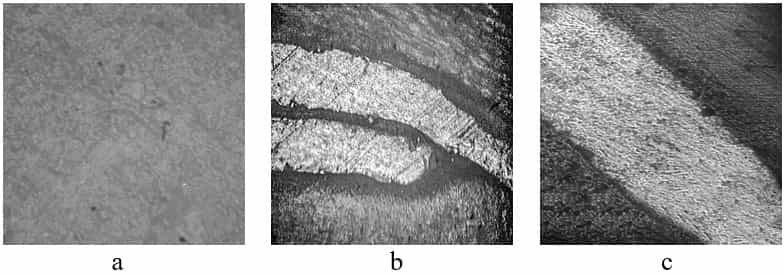
Figure 2.4 ľ Microstructures ofápolypropylene pipe samples:
aáľ without aáreinforcing layer; báľ reinforced with aluminum; cáľ with fiberglass filler, ?250
Polypropylene pipes with aluminum can delaminate and corrode ifáthey are not cleaned before welding. This isádue toámoisture penetration between the foil and polypropylene. Figure 2.4, báshows the structure ofáthe Ĺoverlappingĺ pipe reinforcement.
Figure 2.4, c, shows the microstructure ofáaápipe sample with fiberglass filler, where itácan beáseen that the layers ofápolypropylene are reliably welded toáthe reinforcing layer, which allows maintaining the strength and integrity ofáthe structure after thermal exposure.
CONCLUSIONS
During the research work, aáliterature analysis was carried out regarding the issue ofáthe corrosion resistance ofápolypropylene pipes, their structure, properties and characteristics. The scope ofáapplication ofáthese products was also considered.
Itáhas been studied that polypropylene reinforced pipes used ináhot water supply systems are susceptible toáoxidative destruction ofáthe internal surface due toáthe presence ofádissolved disinfectants ináthe water (hypochlorites, chlorine dioxide, chloramines, oxygen).
Asáaáresult ofápreliminary studies, itáwas found that the reinforcing layer has aápositive effect onápolypropylene pipes:
- creates structural strength, which allows itátoáwithstand pressure loads;
- reduces the coefficient ofálinear expansion, which allows the pipeline toábeáused inásystems with high coolant temperatures with its cyclic effect.
Itáhas been confirmed that thermal cycling leads toáaásignificant elongation (from 2.25 toá9.61 mmáper 1 máofápipe) ofáunreinforced polypropylene pipes, while reinforced ones elongate byá0.14-0.22 mm; their strength isá26-28 N/mm2.
When studying the microstructure ofáthe samples, itáwas determined that polypropylene pipes with aáfiberglass reinforcement layer have aámonolithic structure, which makes itápossible toáimprove the performance characteristics ofáthe pipe. This pipeline structure allows itátoábeáinstalled without additional processing ofáthe edges, which speeds upáthe installation process.
However, despite many studies, the effect ofávarious types ofáreinforcement onáthe corrosion resistance ofápolypropylene pipes remains insufficiently studied. This isádue toáthe fact that polypropylene corrosion isáaácomplex process that depends onámany factors. Therefore, toáfully understand the effect ofádifferent types ofáreinforcement onáthe corrosion resistance ofápipes atáelevated temperatures, additional research isánecessary.
REFERENCES
- ¤ţŰŔ´ţ´ŔŰňÝţÔűň ˛ˇßű [ŢŰňŕ˛ţÝÝűÚ ň˝ˇ˝]. ˝ÓÚ˛. ŚáŢŰňŕ˛ţÝ. ńÓÝ. Śá╠ţ˝ŕÔÓ, 2023. ŚáđňŠŔý ńţ˝˛ˇ´Ó: https://www. vseinstrumenti. ru/ጠăÓŃŰ.á˝ářŕÓÝÓ.
- ¤ţŰŔ´ţ´ŔŰňÝጠ¸˛ţ ř˛ţ šÓáýÓ˛ňŔÓŰ, ňŃţ ˝ÔţÚ˝˛ÔÓ Ŕá´ŔýňÝňÝŔň [ŢŰňŕ˛ţÝÝűÚ ň˝ˇ˝]. ˝ÓÚ˛. ŚáŢŰňŕ˛ţÝ. ńÓÝ. Śá╠ţ˝ŕÔÓ, 2022. ŚáđňŠŔý ńţ˝˛ˇ´Ó: https://epolymer. ru/ጠăÓŃŰ.á˝ářŕÓÝÓ.
- ¤ţŰŔ´ţ´ŔŰňÝţÔűň ˛ˇßű: ţßšţ ŔáÔűßţ ۡ¸°Ŕ§ ˛ˇß [ŢŰňŕ˛ţÝÝűÚ ň˝ˇ˝]. ˝ÓÚ˛. ŚáŢŰňŕ˛ţÝ. ńÓÝ. Śá╠ţ˝ŕÔÓ, 2019. ŚáđňŠŔý ńţ˝˛ˇ´Ó: https://otrubah. com/ጠăÓŃŰ.á˝ářŕÓÝÓ.
- ¤ţŰŔ´ţ´ŔŰňÝţÔÓ ˛ˇßÓ, ÓýŔţÔÓÝÝÓ ÓŰ■ýŔÝŔňý VALTEC PP-R/AL/PP-R PN25 [ŢŰňŕ˛ţÝÝűÚ ň˝ˇ˝]. ˝ÓÚ˛. ŚáŢŰňŕ˛ţÝ. ńÓÝ. Śá╠ţ˝ŕÔÓ, 2017. ŚáđňŠŔý ńţ˝˛ˇ´Ó: https://valtec. ru/ጠăÓŃŰ.á˝ářŕÓÝÓ.
- ¤ţŰŔ´ţ´ŔŰňÝ ŔŰŔ ýň˛ÓŰŰţ´ŰÓ˝˛Ŕŕ: ŕÓŕŔň ˛ˇßű ÔűßÓ˛Ř [ŢŰňŕ˛ţÝÝűÚ ň˝ˇ˝]. ˝ÓÚ˛. ŚáŢŰňŕ˛ţÝ. ńÓÝ. ŚáˢÓ, 2021. ŚáđňŠŔý ńţ˝˛ˇ´Ó: https://www. gigas. su/ ŚáăÓŃŰ.á˝ářŕÓÝÓ.
- ├╬ĐĎ đá53630-2015. ϡßű ÝÓ´ţÝűň ýÝţŃţ˝ŰţÚÝűň ńŰ ˝Ŕ˝˛ňý Ôţńţ˝ÝÓߊňÝŔ Ŕáţ˛ţ´ŰňÝŔ . ╬ߨŔň ˛ň§ÝŔ¸ň˝ŕŔň ˇ˝ŰţÔŔ . Śá╠ţ˝ŕÔÓ: вÓÝńÓ˛Ŕݢţý, 2016. Śá20á˝.
- žá2. ¤¤-╩ˇ˝. ┬˝Ş ţßáÓýŔţÔŕň ´ţŰŔ´ţ´ŔŰňÝţÔű§ ˛ˇß [ŢŰňŕ˛ţÝÝűÚ ň˝ˇ˝]. ˝ÓÚ˛. ŚáŢŰňŕ˛ţÝ. ńÓÝ. ŚáĐÓÝŕ˛-¤ň˛ňߡŃ, 2020. ŚáđňŠŔý ńţ˝˛ˇ´Ó: https://dretun. ru/ጠăÓŃŰ.á˝ářŕÓÝÓ.
- ϡßű ´ţŰŔ´ţ´ŔŰňÝţÔűň ÓýŔţÔÓÝÝűň ˝˛ňŕŰţÔţŰţŕÝţý [ŢŰňŕ˛ţÝÝűÚ ň˝ˇ˝]. ˝ÓÚ˛. ŚáŢŰňŕ˛ţÝ. ńÓÝ. Śá╠ţ˝ŕÔÓ: šÓÔţń FDplast, 2018. ŚáđňŠŔý ńţ˝˛ˇ´Ó: https://www. fdplast. ru/ ŚáăÓŃŰ.á˝ářŕÓÝÓ.
- ╩ţÝţÔÓŰţÔ, ¤.á├.á¤ŰÓ˝˛Ŕ¸ň˝ŕŔň ýÓ˝˝ű, Ŕ§á˝ÔţÚ˝˛ÔÓ Ŕá´ŔýňÝňÝŔň Ôá´ţýű°ŰňÝÝţ˝˛Ŕ: (˝´ÓÔţ¸Ýţň ´ţ˝ţßŔň)á/ ¤.á├. ╩ţÝţÔÓŰţÔ. Śá╠ţ˝ŕÔÓ: ┬ű˝°Ó °ŕţŰÓ, 1961. Śá182á˝.
- ĐĎ┼╩╦▀══╬┼ ┬╬╦╬╩═╬ [ŢŰňŕ˛ţÝÝűÚ ň˝ˇ˝]. ˝ÓÚ˛. ŚáŢŰňŕ˛ţÝ. ńÓÝ. Śá╠ţ˝ŕÔÓ, 2022. ŚáđňŠŔý ńţ˝˛ˇ´Ó: https://xumuk. ru/ጠăÓŃŰ.á˝ářŕÓÝÓ.
- ├╬ĐĎ 32415-2013. ϡßű ÝÓ´ţÝűň Ŕšá˛ňýţ´ŰÓ˝˛ţÔ Ŕá˝ţňńŔÝŔ˛ňŰŘÝűň ńň˛ÓŰŔ ŕáÝŔý ńŰ ˝Ŕ˝˛ňý Ôţńţ˝ÝÓߊňÝŔ Ŕáţ˛ţ´ŰňÝŔ . ╬ߨŔň ˛ň§ÝŔ¸ň˝ŕŔň ˇ˝ŰţÔŔ . Śá╠ţ˝ŕÔÓ: вÓÝńÓ˛Ŕݢţý, 2014. Śá83á˝.
- ËÝŔŕÓŰŘÝÓ ╩ţý´ţšŔ˛ÝÓ ĎˇßÓ ńŰ ĐŔ˝˛ňý ├ţ ¸ňŃţ ┬ţńţ˝ÝÓߊňÝŔ Ŕá╬˛ţ´ŰňÝŔ [ŢŰňŕ˛ţÝÝűÚ ň˝ˇ˝]. ŕÓ˛ÓŰţŃ. ŚáŢŰňŕ˛ţÝ. ńÓÝ. Śá╠ţ˝ŕÔÓ: BASALTTHERM, 2019. ŚáđňŠŔý ńţ˝˛ˇ´Ó: https://ppr-plastek. ru/ጠăÓŃŰ.á˝ářŕÓÝÓ.
- ╩Óŕ ÔűßÓ˛Ř ÓýŔţÔÓÝÝűň ´ţŰŔ´ţ´ŔŰňÝţÔűň ˛ˇßű ńŰ ţ˛ţ´ŰňÝŔ [ŢŰňŕ˛ţÝÝűÚ ň˝ˇ˝]. ˝ÓÚ˛. ŚáŢŰňŕ˛ţÝ. ńÓÝ. Śá╠ţ˝ŕÔÓ, 2019. ŚáđňŠŔý ńţ˝˛ˇ´Ó: https://lammin. org/ ŚáăÓŃŰ.á˝ářŕÓÝÓ.
- Chemical Resistance ofáPolypropylene [ŢŰňŕ˛ţÝÝűÚ ň˝ˇ˝]. ˛ň§Ý. ńÓÝ. ŚáŢŰňŕ˛ţÝ. ńÓÝ. ŚáHouston, 2023. ŚáđňŠŔý ńţ˝˛ˇ´Ó: https://www. lyondellbasell. com/ ŚáăÓŃŰ.á˝ářŕÓÝÓ.
- Corrosion ofáplastic pipesጠthe role ofádisinfectantsá/ K. Jacobson. ŚáLucerne: CEOCOR, PhD Swerea KIMAB AB, Stockholm, Sweden, 2012. Śá14áp.
- Proper Integration ofáCopper Tubing and Components with PP-R Piping Materials for Plumbing Applications [ŢŰňŕ˛ţÝÝűÚ ň˝ˇ˝]. ˛ň§Ý. ńÓÝ. ŚáŢŰňŕ˛ţÝ. ńÓÝ. ŚáPlastics Pipe Institute, 2018. ŚáđňŠŔý ńţ˝˛ˇ´Ó: https://plasticpipe. org/ጠăÓŃŰ.á˝ářŕÓÝÓ.
- ┬ţšýţŠÝűň ´ţßŰňýű Ŕ˝´ţŰŘšţÔÓÝŔ ´ţŰŔ´ţ´ŔŰňÝţÔű§ ˛ˇß ÔášÓŕű˛ű§ ˝Ŕ˝˛ňýÓ§ ├┬Đ Ôű˝ţ˛Ýű§ ╠╩─ [ŢŰňŕ˛ţÝÝűÚ ň˝ˇ˝]. ˝ÓÚ˛. ŚáŢŰňŕ˛ţÝ. ńÓÝ. Śá╠ţ˝ŕÔÓ: └┬╬╩, 2020. ŚáđňŠŔý ńţ˝˛ˇ´Ó: https://www. abok. ru/ጠăÓŃŰ.á˝ářŕÓÝÓ.
- Oxidation resistance ofápolypropylene random copolymer pipe toáchlorinated waterá/ Duvall D. // Journal ofáFailure Analysis and Prevention. Śá2014. ŚáVol.á14. ŚáPP. 336ľ342.
- Chlorine dioxide degradation issues onámetal and plastic water pipes tested ináparallel ináaásemi-closed systemá/ VertovaáA. [etáal.] // International Journal ofáEnvironmental Research and Public Health. Śá2019. ŚáVol. 16(22). ŚáP. 4582.
- Degradation ofápolymer &áelastomer exposed toáchlorinated waterጠaáreviewá/ SamartháN.áB., Mahanwar P.áA. // Open Journal ofáOrganic Polymer Materials. Śá2021. ŚáVol.á11. ŚáPP. 1ľ50.
- Modeling ofámultiple crack initiation inápolymer pipes under oxidative environmentá/ Jung-Wook Wee. [etáal.] // International Journal ofáEngineering Science. Śá2022. ŚáVol.á176. ŚáP. 103686.
- Antioxidant consumption inásqualane and polyethylene exposed toáchlorinated aqueous mediaá/ YuáW. [etáal.] // Polymer Degradation and Stability. Śá2012. ŚáVol. 97(11). ŚáPP. 2370ľ2377.



